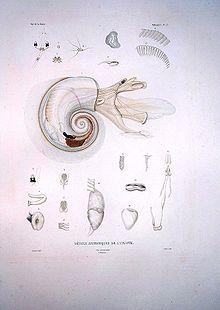Atlanta (gastropod)
|
Atlanta Temporal range: Bartonian–Recent Bartonian-Recent |
|
|---|---|
 |
|
| Atlanta anatomy | |
| Scientific classification | |
| Kingdom: | Animalia |
| Phylum: | Mollusca |
| Class: | Gastropoda |
| (unranked): | clade Caenogastropoda clade Hypsogastropoda clade Littorinimorpha |
| Superfamily: | Pterotracheoidea |
| Family: | Atlantidae |
| Genus: |
Atlanta Lesueur, 1817 |
| Type species | |
|
Atlanta peronii Lesueur, 1817 |
|
| Species | |
|
See text |
|
| Synonyms | |
|
Steira Eschscholtz, 1825 |
|
See text
Steira Eschscholtz, 1825
Atlanta is a genus of pelagic marine gastropod molluscs in the family Atlantidae. They are sometimes called heteropods.
All of the nineteen species but one, Atlanta californiensis, dwell in tropical and subtropical waters. The majority of species (ten) are cosmopolitan and, among the remaining nine species, five are Indo-Pacific, two are restricted to the Pacific Ocean, one is Indo-Atlantic, and one is limited to the Atlantic Ocean.
They are floating or swimming snails in tropical and subtropical seas. Most have a cosmopolitan distribution, but A. brunnea, A. pulchella and A. quoyi are only found in American waters. A. fusca, A. pacifica and A. rosea are restricted the seas around Japan.
It has been recognized by several authors that identification of species in this genus is difficult and is dependent on their morphology of eyes, radula and operculum.
Main diagnostic features include: the shell and keel are calcareous; larval shell becomes the spire in the adult shell.
Snails of this genus are very small. Their coiled, calcareous shell has a diameter of less than 1 cm. The of the larval shell is retained after metamorphosis and becomes the spire of the adult shell. The number of spire whirls varies from 2½ (in the A. lesueuri- group) to 6 (A. gibbosa) and is thus also helpful in the identification of a species. The spire shape differs between the species groups, from very small (A. lesueuri- group), to inflated or flat (A. inflata- group ) to large (A.inclinata- group and A. gibbosa- group).
They can retract into their shell and close it off with an operculum. This operculum is cartilaginous and flexible. In 1961 Richter distinguished three types of the operculum in which the larval gyre of the operculum is apical. This gyre can be relatively somewhat larger (macro-oligogyre), smaller (micro-oligogyre) or a single gyre (monogyre).
...
Wikipedia
